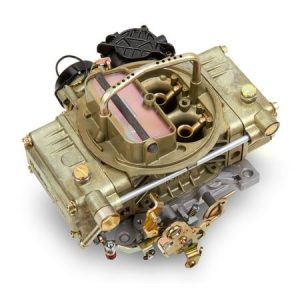The world of car engines can seem complex, filled with an array of technical terms and intricate designs. But understanding the basic functionalities of different engine types can be surprisingly accessible. This article delves into the world of pushrod engines, a simple yet effective design that has powered countless vehicles for decades.
Whether you’re a seasoned car enthusiast or just starting to explore the inner workings of your car, this guide will provide a comprehensive understanding of pushrod engines. We’ll explore their history, design principles, advantages and disadvantages, and how they compare to other engine types.
A Legacy of Simplicity: The History of Pushrod Engines
Pushrod engines, also sometimes referred to as overhead valve (OHV) engines, have a long and storied history. Their origins can be traced back to the early days of automobiles, predating more complex overhead camshaft (OHC) engine designs.

The simplicity of the pushrod engine design was a major advantage in the early days of car manufacturing. Here’s a breakdown of the key components:
-
Camshaft: Located within the engine block, the camshaft has lobes that push on specially designed followers.
-
Pushrods: These metal rods transfer the camshaft’s motion from the block up to the cylinder head.
-
Rocker Arms: Situated in the cylinder head, rocker arms pivot and translate the pushrod’s up-and-down motion into a rocking motion that opens and closes the valves.
-
Valves: The valves control the intake of air-fuel mixture and the exhaust of burnt gases in the engine cylinders.
This relatively straightforward design made pushrod engines easy to manufacture and maintain, contributing to their widespread adoption in early automobiles.
The Core Mechanics: How Pushrod Engines Work
While seemingly simple in concept, the precise choreography of components within a pushrod engine is what generates power. Here’s a simplified breakdown of the process:
-
Crankshaft Rotation: The engine’s crankshaft spins, converting the power from pistons moving up and down in the cylinders into rotational force.
-
Camshaft Actuation: Connected to the crankshaft by gears or a timing chain, the camshaft rotates in sync with the crankshaft. The lobes on the camshaft come into contact with the followers at specific intervals.
-
Pushrod Movement: The followers, which sit on top of the pushrods, are pushed upwards by the camshaft lobes.

-
Rocker Arm Action: The pushrods transfer this upward motion to the rocker arms. As the rocker arms pivot, they push down on the valve stems, opening the valves.
-
Intake and Exhaust Cycles: During the intake cycle, the intake valve opens, allowing the air-fuel mixture to enter the cylinder. In the exhaust cycle, the exhaust valve opens, allowing burnt gases to escape the cylinder.
-
Valve Spring Closure: A spring connected to each valve ensures it closes once the rocker arm pressure is relieved by the camshaft lobe.
This synchronized dance of the camshaft, pushrods, rocker arms, and valves is what controls the breathing of the engine, allowing fresh air and fuel to enter and spent gases to exit the cylinders, generating power.
The Advantages of Pushrod Engines: Why Simplicity Matters
Despite the emergence of more complex engine designs, pushrod engines continue to hold their own in certain applications. Here are some of their key advantages:
-
Durability and Reliability: The simple and robust design of pushrod engines makes them inherently reliable and less prone to certain failures compared to some OHC engines with more complex valve actuation mechanisms.
-
Lower Manufacturing Costs: The simpler design translates to lower production costs, making pushrod engines an attractive option for certain vehicle segments, particularly trucks and budget-oriented cars.
-
Low Center of Gravity: With the camshaft located within the engine block, pushrod engines tend to have a lower center of gravity compared to OHC engines where the camshaft sits atop the cylinder head. This can contribute to better handling characteristics.

-
Easier Maintenance: The accessibility of components in a pushrod engine often makes maintenance and repairs simpler and less expensive compared to some OHC engines.
-
Torque Production: Pushrod engines can be particularly adept at generating low-end torque, making them well-suited for applications that require strong pulling power, such as towing and hauling.
Pushrod vs. Overhead Cam (OHC) Engines: Weighing the Differences
While pushrod engines offer advantages in terms of simplicity and affordability, OHC engines have become increasingly popular due to certain performance benefits. Here’s a breakdown of the key differences:
-
Valve Actuation: Pushrod engines rely on pushrods and rocker arms to actuate the valves, while OHC engines have the camshaft positioned directly above the valves, eliminating the need for these intermediary components.
-
Potential for Higher RPMs: The more direct valve actuation in OHC engines allows for higher engine speeds (RPMs) compared to pushrod engines. This translates to more potential horsepower for performance-oriented applications.
-
Greater Design Flexibility: OHC engines offer more design flexibility in terms of optimizing valve timing and cam profiles, which can contribute to increased power output and efficiency.
-
Complexity and Cost: The more complex design of OHC engines generally translates to higher production costs and potentially more intricate maintenance procedures compared to pushrod engines.
Ultimately, the choice between a pushrod engine and an OHC engine depends on the specific application and priorities. Pushrod engines excel in terms of simplicity, affordability, and low-end torque, making them ideal for work trucks, SUVs, and some muscle cars. OHC engines, on the other hand, prioritize higher power output and potential fuel efficiency, often seen in modern performance cars and many fuel-efficient vehicles.
The Future of Pushrod Engines: Still a Viable Option?
The automotive industry is constantly evolving, with advancements in technology leading to more efficient and powerful engines. So, does this spell the end for pushrod engines? Not necessarily.
Here’s why pushrod engines might remain relevant:

-
Continuous Refinement: Manufacturers continue to refine pushrod engine designs, incorporating modern materials and technologies to improve performance and efficiency while maintaining their inherent advantages.
-
Focus on Specific Applications: The simplicity and affordability of pushrod engines make them a good choice for certain vehicle segments like budget-friendly cars and trucks where raw power isn’t the primary focus.
-
Appeal of Classic Design: For some enthusiasts, the traditional and robust nature of pushrod engines holds a certain charm, ensuring their continued presence in classic car restorations and hot rod projects.
While OHC engines may dominate the high-performance segment, pushrod engines are likely to remain a viable option for specific applications and car enthusiasts for the foreseeable future.
Gear Up for Knowledge: Exploring Pushrod Engines in Your Next Car
Understanding the inner workings of your car engine can enhance your appreciation for its power and performance. Whether you’re considering buying a new or used car, knowing about pushrod engines equips you to make informed decisions.
Here are some resources to delve deeper into the world of pushrod engines:

-
Online Resources: Numerous automotive websites and forums offer detailed information on pushrod engine design, function, and maintenance.
-
Car Manufacturer Websites: Research the specific engines offered in vehicles you’re interested in to determine if they utilize pushrod or OHC technology.
-
Consult a Mechanic: A qualified mechanic can provide valuable insights into the advantages and considerations of pushrod engines compared to other engine types.
By familiarizing yourself with pushrod engines, you gain a deeper understanding of a time-tested technology that continues to power many vehicles on the road today.
Pushrod Engines – A Legacy of Simplicity and Power
Pushrod engines, despite their seemingly basic design, have played a pivotal role in automotive history. Their enduring legacy lies in their simplicity, durability, and ability to deliver reliable power. While advancements in engine technology continue, pushrod engines are likely to remain a relevant choice for specific applications and a source of fascination for car enthusiasts.
Ready to explore the world of cars with a newfound understanding of pushrod engines? Research different car models and specifications to find the perfect match for your needs and preferences!



